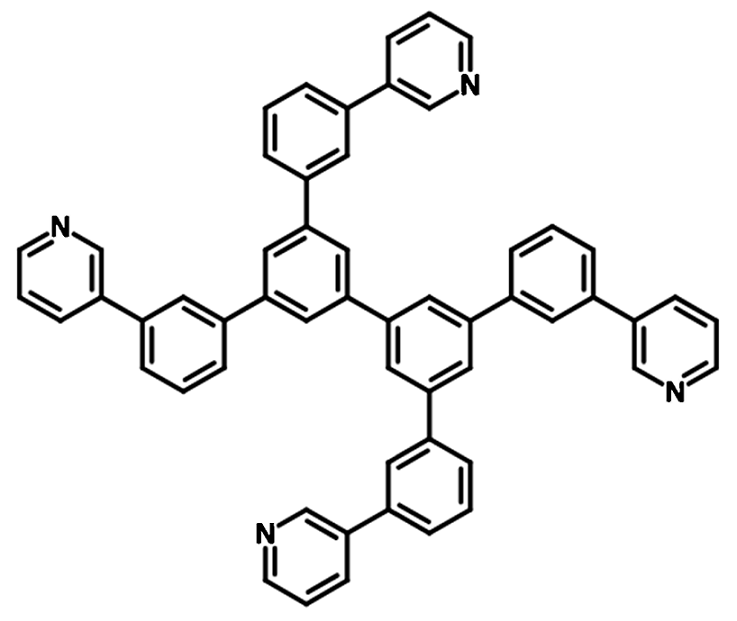BP4mPy, one of the most popular ETL and HBL material used in OLEDs
Paired with electron-donating materials to host red, green, and blue PhOLEDs, 3,3',5,5'-Tetra[(m-pyridyl)-phen-3-yl]biphenyl, CAS No. 1009033-94-6, Sublimed ≥99.0%
BP4mPy, namely 3,3',5,5'-Tetra[(m-pyridyl)-phen-3-yl]biphenyl, is one of the most popular electron-transporting and hole-blocking layer materials used in OLEDs. It is electron deficient due to the electron-withdrawing nature of its four pyridine pendants. Together with electron-donating materials (e.g. TCTA), BP4mPy can also be used as an exciplex host for red, green, and blue phosphorescent OLEDs. BP4mPy aids effective energy transfer from exciplexes to emitters, thus leading to high efficiencies.
General Information
|
CAS number
|
1009033-94-6
|
|
Full name
|
3,3',5,5'-Tetra[(m-pyridyl)-phen-3-yl]biphenyl, 3,5,3',5'-Tetra(3-pyrid-3-ylphenyl)-1,1'-biphenyl.
|
|
Chemical formula
|
C56H38N4
|
|
Molecular weight
|
766.93 g/mol
|
|
Absorption
|
λmax 252 nm in THF
|
|
Fluorescence
|
λmax 352 nm in THF
|
|
HOMO/LUMO
|
HOMO = 6.66 eV, LUMO = 2.57 eV [1]
|
|
Classification / Family
|
Electron-transport layer (ETL) materials, Hole-blocking layer (HBL) materials, TADF materials.
|
Product Details
|
Purity
|
Sublimed > 99% (HPLC)
|
|
Melting point
|
Tg = 105 °C
|
|
Appearance
|
Off-white crystals/powder
|
Chemical Structure

Chemical Structure of BP4mPy; CAS No. 1009033-94-6
Device Structure(s)
|
Device structure
|
ITO (90 nm)/TAPC (65 nm)/TCTA (5 nm)/26DCzPPy:4 wt% B-2PXZ (30 nm)/BP4mPy (40 nm)/LiF (0.8 nm)/Al (150 nm) [2]
|
|
Colour
|
Yellow 
|
|
Max. Power Efficiency
|
20.3 lm W−1
|
|
Max. Current Efficiency
|
32.2 cd/A
|
|
Max. EQE
|
10.1%
|
|
Device structure
|
ITO (110 nm)/TAPC (30 nm)/mCP:1.0 wt% Os(bpftz)2(PPhMe2)2* (1 nm)/mCP:8.0 wt% Ir(bptz)2(bdp)* (18 nm)/mCP:7.0 wt% Os(bpftz)2(PPhMe2)2* (1 nm)/BP4mPy (50 nm)/LiF (0.8 nm)/Al (150 nm) [3]
|
|
Colour
|
White 
|
|
Max. Power Efficiency
|
10.39 lm W−1
|
|
Max. Current Efficiency
|
13.25 cd/A
|
|
Max. EQE
|
6.16%
|
|
Device structure
|
ITO/TAPC (40 nm)/mCP:Complex 2* 1 wt% (30 nm)/BP4mPy (40 nm)/LiF (0.8 nm)/Al (150 nm) [4]
|
|
Colour
|
Green 
|
|
Max. Power Efficiency
|
22.6 lm W−1
|
|
Max. Current Efficiency
|
30.3 cd/A
|
|
Max. EQE
|
10.0%
|
|
Device structure
|
ITO (90 nm)/TAPC:20 wt % of MoO3 (20 nm)/TAPC (30 nm)/26DCzPPy and x wt % PXZBM* (30 nm)/BP4mPy (40 nm)/LiF (0.8 nm)/Al (150 nm) [5]
|
|
Colour
|
Green 
|
|
Max. Power Efficiency
|
50.0 lm W−1
|
|
Max. Current Efficiency
|
67.7 cd/A
|
|
Max. EQE
|
22.6%
|
|
Device structure
|
ITO (110 nm)/TAPC (30 nm)/mCP and 8.0 wt% [Os(pz2py)(PPh2Me)2(CO)]* (30 nm)/BP4mPy (50 nm)/LiF (0.8 nm)/Al (150 nm) [6]
|
|
Colour
|
Yellow 
|
|
Max. Power Efficiency
|
53.8 lm W−1
|
|
Max. Current Efficiency
|
61.0 cd/A
|
|
Max. EQE
|
13.8%
|
|
Device structure
|
ITO/TAPC (40 nm)/TCTA 46 wt %:BP4mPy 46 wt %:fac-Ir(ppy)3 8 wt % (30 nm)/BP4mPy (40 nm)/LiF (0.8 nm)/Al (150 nm) [7]
|
|
Colour
|
Green 
|
|
Max. Power Efficiency
|
42.6 lm W−1
|
|
Max. Current Efficiency
|
48.7 cd/A
|
|
Max. EQE
|
14.1%
|
|
Device structure
|
ITO/TAPC (40 nm)/TCTA 46 wt %:BP4mPy 46 wt %:FIrpic 8 wt % (30 nm)/BP4mPy (40 nm)/LiF (0.8 nm)/Al (150 nm) [7]
|
|
Colour
|
Blue 
|
|
Max. Power Efficiency
|
37.9 lm W−1
|
|
Max. Current Efficiency
|
35.6 cd/A
|
|
Max. EQE
|
15.8%
|


 Chemical Structure of BP4mPy; CAS No. 1009033-94-6
Chemical Structure of BP4mPy; CAS No. 1009033-94-6